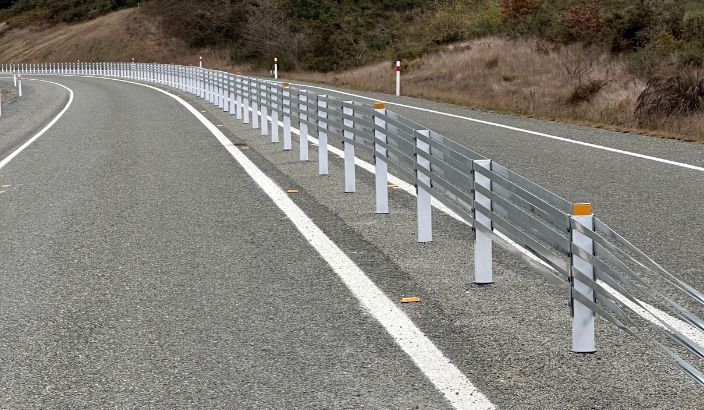‘Complete farce’ – barriers to be replaced


The safety barriers along the Ruby Bay bypass are scheduled to be removed and replaced in early May, less than 12 months after they were installed. Photo: Supplied
Less than a year after new technology ROBOS safety medians were installed along the Ruby Bay bypass, the New Zealand Transport Agency Waka Kotahi is planning to remove and replace them in an act that has been labelled “a complete farce” by the head of ROBOS International Ltd.
The Ruby Bay site is the first in the world to be fitted with the ROBOS barriers, which executive director Don Jaine says is on track to be “the best system in the world for median barriers, full stop, finish”.
However, due to issues with installation and maintenance, NZTA states the trial is being prematurely ended and replaced with a wire barrier system early next month.
Don supplied documentation to The Guardian to demonstrate the ROBOS system’s effectiveness. He says the traditional wire rope barriers can “act as a saw” and cut into vehicles, while the ROBOS system uses four steel straps, which are mounted on the vehicle-facing side of the support posts.
In an impact, cars are more likely to slide along the straps, rather than crashing into centre posts. Don says that the ROBOS system performs extremely well in MASH TL 4 testing – the highest performance testing criteria for safety median barriers – with regards to deflection, which determines how far a vehicle breaches the barrier into the opposite lane.
He acknowledges that some of the cable barriers are also of MASH TL4 standard, but stands firm that testing has proven that the ROBOS barriers surpass them, with less risk to both the “offending” vehicle and other vehicles on the road.
“ROBOS deflects much less and it’s a smooth surface for the crash vehicle with no exposed posts,” he explains.
Real-world proof of this could be seen in a crash in late February, he says, where a vehicle hit the system with enough force to take out 16 posts.
“That person drove away and [we] never saw them again,” he says. “It’s unheralded.”
The company entered a two-year contract with NZTA, and Don agrees there were many installation problems to be worked through on the ground. Due to time delays, the original three sections of planned installation were stripped back to two.
“There’s plenty of things we did wrong – we’re the first to acknowledge that – but we’ve fixed them.”
He says the original issues included post heights and alignment, galvanising paint, replacement of some faulty parts, “and a range of small modifications – mostly at the request of NZTA”.
The most recent issue occurred when the system was being re-tensioned in November, which resulted in two of the 80 welds failing.
Don says they discovered that the winter installation had left some of the laser welds porous.
“New plates are ready to be welded across all 80 original welds on the steel straps, which will leave the system stronger than initial plans.”
He says this work will take two nights of road closures and would be overseen by independent engineering firm BECA Group.
As it stands, the NZTA website states that “drivers travelling on the State Highway 60 Ruby Bay Bypass in Tasman District can expect to see further works from early May on a 2.7-kilometre section of safety barrier”.
This includes three weeks of night closures from 4 May. An NZTA spokesperson confirmed that the barrier was being replaced during these works.
“The ROBOS system was installed as a trial. During installation and maintenance work undertaken on the ROBOS barrier, a number of issues were experienced, including the problems with the welds.
“Given the issues experienced, NZTA has decided that the best course of action is to end the trial, remove the ROBOS barrier system from the network and replace it with the traditional barrier system that is already installed on other sections of the bypass.”
Don says that NZTA plans to replace the barriers with an inferior product with lower test bearings, and at a cost of $500,000 to the taxpayer. NZTA has yet to comment on these points.
He is asking for his company to be given the opportunity to repair the welds and re-tension the barrier at its own expense, and for the contract to remain until the two-year period is up.
Don says ROBUS International Ltd has $10m of private investors, and “unless we leave this in the ground, we’re pretty much dead – at least in New Zealand. And yet another New Zealand start-up with significant international prospects will be scuttled by this unfathomable act of bureaucracy.”
He calls the current wire rope suppliers “a cosy duopoly” and believes they are working to keep ROBOS out of the market. Due to the holiday weekend, NZTA has had limited opportunity to reply to The Guardian regarding this issue – any follow-up comments will be published next week.
